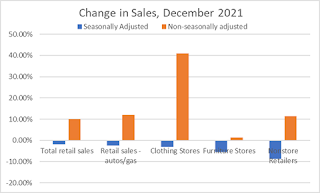A couple of signs that omicron’s breakout may finally be having an effect on the economy.
Retail sales had a sizable (seasonally-adjusted) decline in December, but were way up compared to where we were at the end of 2020.
Advance estimates of U.S. retail and food services sales for December 2021, adjusted for seasonal variation and holiday and trading-day differences, but not for price changes, were $626.8 billion, a decrease of 1.9 percent (±0.5 percent) from the previous month, but 16.9 percent (±0.9 percent) above December 2020. Total sales for the 12 months of 2021 were up 19.3 percent (±0.5 percent) from 2020. Total sales for the October 2021 through December 2021 period were up 17.1 percent (±0.7 percent) from the same period a year ago. The October 2021 to November 2021 percent change was revised from up 0.3 percent (±0.5 percent)* to up 0.2 percent (±0.3 percent)*.
Retail trade sales were down 2.1 percent (±0.4 percent) from November 2021, but up 14.4 percent (±0.7 percent) above last year. Gasoline stations were up 41.0 percent (±1.6 percent) from December 2020, while food services and drinking places were up 41.3 percent (±4.0 percent) from last year.
But much of this reflects the fact that Holiday shopping isn’t the one-time boost that it used to be. Americans actually spent a lot more dollars in December compared November. It just wasn’t as much of a boost as it usually is.
It’s a warning sign, but to me I want to see whether January has a “gain” simply because the dropoff isn’t as much as the past, as shopping may well not change from month-to-month as it may have a few years ago.
A bigger worry is what we’ve seen with January reports in the last few days, particularly a
sizable rise in unemployment claims last week. It may be a seasonal quirk as well (an actual decline of 83,400 in the week after New Year’s = seasonal “gain” of 55,000), or maybe some places are shutting down due to a lack of staff/business due to omicron.
We also saw that
IHS Markit reported softening business conditions in January, with omicron cited as a big reason why.
Adjusted for seasonal factors, the IHS Markit Flash US Composite PMI Output Index posted 50.8 in January, down notably from 57.0 in December. The resulting upturn in activity was only marginal, and the slowest since July 2020.
The slowdown in output growth was broad-based, with both manufacturing and service sector firms reporting near-stalled output as the steep spike in virus cases associated with the Omicron wave meant ongoing supply issues and labor shortages were exacerbated by renewed pandemic related containment measures.
Although output was constricted by the Omicron wave, demand growth remained more resilient. New orders for goods and services continued to rise strongly, albeit registering the weakest rise since December 2020. The upturn in new orders was supported by the service sector, as manufacturers stated that new sales growth was often held back by weaker demand from clients amid price rises and efforts to work through inventories. Renewed restrictions in key export markets and raw material shortages also led to a softer upturn in new export orders.
Granted, 50.8 is still growth, but it does seem to indicate the Biden Boom of 2021 may be slowing as some people don’t go out as much or can’t produce as much due to the cloud of omicron that has loomed over much of this month.
On the flip side, the same report listed inflation slowing to its lowest levels since May, so this may be how things even out for a bit. At 3.9% unemployment, we probably shouldn’t expect to have much further to go anyway, but Wall Street’s
fears of having their low-rate cocaine party end concerns over foreign instability means wild rides
like today’s 1,100+ point difference between peak and valley may be happening more than most would like.
So keep it smart and safe in the coming days and weeks, and let’s see if we get a better idea on direction for 2022 as things mellow out. If they mellow out.

No comments:
Post a Comment